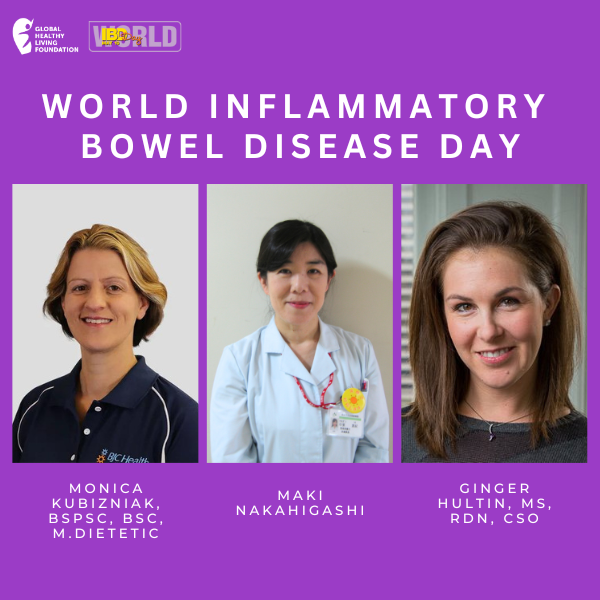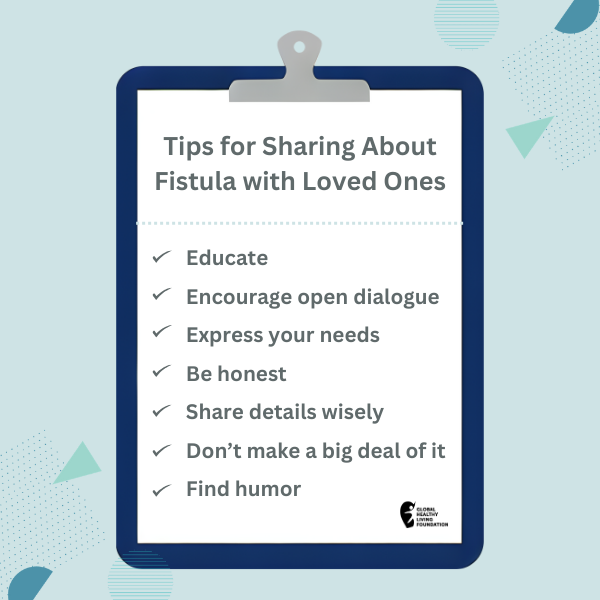In honor of World IBD Day, dietitians from three different continents share tips on managing diet and inflammatory bowel disease (IBD).
What You Need to Know About Complex Perianal Fistula If You Have Crohn’s Disease
What You Need to Know About Complex Perianal Fistula If You Have Crohn’s Disease
March 9, 2020
Anne M. Sydor

Check out Your Guide to Understanding Complex Perianal Fistula for more information on this topic.
There are multiple causes of perianal fistulas, including Crohn’s disease. Here we take a look at complex perianal fistulas in people who also have Crohn’s disease, treatment options for fistula, and how to choose your health care team.
What Is a Complex Perianal Fistula?
Crohn’s disease causes problems in the area around the anus, called the perianal region, in about one of every three people who have the disease. Crohn’s disease is a type of inflammatory bowel disease that causes open sores called ulcers in the lining of the digestive tract. These sores can break through the intestine.
When this happens, tunnel-like structures form and connect the intestine to the skin or muscles in the perianal region. These connections are also called tracts or fistulas and can become painful and easily infected. Most fistulas need medical or surgical treatment or both.
Perianal fistulas are considered “complex” if they:
- Involve a large part of the sphincter muscle, which opens and closes the anus
- Branch or have more than one opening into muscle or skin
- Become infected or form a pus-filled sac inside called an abscess
- Involve the rectum or vagina
- Are in a person with inflammatory bowel disease, fecal incontinence, chronic diarrhea, or anorectal cancer (not all doctors and guidelines use this definition of complex)
About one in every four people with Crohn’s disease will have a fistula in their lifetime.
How Are Complex Fistulas Treated?
The best treatment for perianal fistulas is a combination of medication and minor surgery, called seton placement. This combination of treatments is successful for about one of every three people with perianal fistula. Some people, however, will also need more complex surgeries.
It is important to have a team of doctors and surgeons involved in this care. This team includes a gastroenterologist, a doctor that specializes in diseases of the digestive tract, and a colorectal surgeon who specializes in perianal surgery.
Seton Placement
A seton is a piece of surgical thread that is left in the fistula for several weeks to keep it open (a technique first described by Hippocrates in ancient Greece). Leaving the thread in the fistula keeps it open, allowing it to drain and heal. The seton should not stay in place for more than a year.
Before surgery, most patients have imaging studies to show where the fistula opens and closes. Some people need anesthesia during these imaging studies. During seton placement and removal, sedation is used to keep you comfortable. Many surgeons also use general anesthesia so that patients are not awake during the procedure.
Adding the drugs azathioprine or methotrexate may also improve the chances of treatment success. These drugs are in a class called immunosuppressants. Other immunosuppressants (e.g., corticosteroids, cyclosporine) are not useful for treating perianal fistula.
When seton placement surgery — with or without immunosuppressants – does not close the fistula, different medicines called TNFis (tumor necrosis factor inhibitors) can be tried.
Complex Surgery
Choosing which type of surgery to have depends on where the fistula is located, if it is infected, and both the patient’s and surgeon’s preferences.
When choosing a type of surgery, it can be helpful for patients focus on their goals — what do you want to get out of the surgery? It may be helpful to ask the health care team to explain what could happen in the best and worst cases for each type of surgery they suggest. Knowing that the reality is likely to be somewhere in between best and worst, you can then compare treatments.
The risks of surgical procedures are infection, fecal incontinence, and recurrence of the fistula. These risks are higher for people with Crohn’s disease because of the ongoing disease process that makes it more difficult for the perianal region to heal. Before any procedure, the exact path of the fistula is determined with MRI, ultrasound, or a physical examination (often under anesthesia to control pain).
In flap surgery, the surgeon cleans out the fistula and stitches a piece of tissue from the rectum (the lowest part of the large intestine just above the anus) over the opening to the fistula. About two of every three people have successful treatment with this method, but that number is lower in people with Crohn’s disease.
If a fistula passes through the sphincter muscle around the anus that opens and closes the anus, the LIFT procedure (ligation of the intersphincteric fistula tract) may preserve the function of that muscle. The surgeon makes a small cut above the fistula and uses a stitch to close each opening. Next, the surgeon washes out the fistula so it can heal. This procedure is successful in people with Crohn’s disease about two of three times that it is done. The risk of incontinence is much lower with the LIFT procedure than with flap surgery.
A surgeon can also inject a “plug” of biologic material (e.g., collagen or fibrin) into the fistula to try to seal it. This is effective for simple fistulas, but it is unclear whether it increases the success of treatment in Crohn’s disease.
In a treatment that is in development, surgeons place a stem-cell treatment, called darvadstrocel, in the fistula. There is convincing evidence that this may be more effective than other surgical treatments.
Even with the best medical and surgical treatments, fistulas may not fully heal or may come back. Sometimes an ostomy-and-stoma procedure is needed to divert feces from the anus so that it can heal. An opening is created in the abdomen and the large intestine is connected to it. Waste flows into a bag that must be emptied regularly. Healthcare teams usually make every possible effort to make this a temporary solution.
For most people, the intestine can be reconnected after the anus has healed. Others, however, will need to use this as a permanent solution.
Thinking about fistulas and the possible need for surgery can cause stress, worry, and fear. Remember, you are not alone. Support groups for people with Crohn’s disease and other resources are available. It is important to learn what you can and ask questions.
Choosing Your Care Team
Whenever possible, it is good to have health care from a team from different areas of medicine who work together. This may include your:
- Primary care provider
- Gastroenterologist
- Colorectal surgeon
- Social worker
- Psychologist
This model of care may make it possible to talk with and get to know a surgeon before surgery is needed. Building these relationships early also means that if and when surgery is needed, someone will be there for you.
If there is not a multidisciplinary care team available where you are, consider talking to your doctors and nurses about how likely it is that you will eventually need surgery. Ask if there are surgeons they typically send their patients for surgery. Also, find out if you can meet and consult with some of these surgeons when you don’t need surgery so that you can have someone in place if surgery is ever needed in the future.
Except in cases of life-threatening emergencies, the choice of when to be referred for surgery is individual and can be made in consultation with your health care team. When symptoms are not well-controlled with medicine or are only partially controlled, you may decide that surgery is worth it for you.
This can be an ongoing conversation with your team and is ultimately about what levels of pain and discomfort you are willing to tolerate and what quality of life means to you personally
Relying on Experience
When choosing your health care team members — multidisciplinary or not — it is best to find people who have experience treating Crohn’s disease. This is especially true for surgeons.
Whenever possible, choose a surgeon who has performed the surgery you are going to have multiple times. You should be able to get an answer easily to the question of how many times a surgeon has done the procedure each year to get a sense of their experience (more is better).
You can also rely on the experience of other people with Crohn’s disease by seeking out in-person and online support groups. Some helpful things that people have said about their surgeries include:
- “Coming to terms with needing surgery is a process. Take time to find out what your needs are and to adjust physically and emotionally.”
- “Learning from other people’s experiences was empowering for me even when their experiences were different from my own.”
- “Hang in there, it is okay to not be okay some of the time.”
- “Find a surgeon willing to adjust the plans according to what is most important to you.”
- “Over time, surgery gave me a much better quality of life.”
Fistulas are a common complication of Crohn’s disease that are best treated with a combination of medication and surgery by a multidisciplinary team. Whenever possible, finding a team of people who will work with you as the most important team member and adapt treatment to your life goals is helpful.
Learning from other people with Crohn’s disease who are considering or have experienced surgery can be an empowering way to come to terms with your needs and improve your quality of life.
Badla O, Goit R, Saddik SE, et al. The Multidisciplinary management of perianal fistulas in Crohn’s disease: a systematic review. Cureus. September 20, 2022. doi: https://doi.org/10.7759/cureus.29347.
Ciccocioppo R, et al. Systematic review with meta-analysis: Safety and efficacy of local injections of mesenchymal stem cells in perianal fistulas. JGH Open. February 13, 2019. doi: https://doi.org/10.1002/jgh3.12141.
Feuerstein JD, et al. AGA Clinical Practice Guidelines on the Medical Management of Moderate to Severe Luminal and Perianal Fistulizing Crohn’s Disease. Gastroenterology. 2021. doi: https://doi.org/10.1053/j.gastro.2021.04.022.
Surgery for Crohn’s Disease. Crohn’s and Colitis Foundation. August 9, 2020. https://www.crohnscolitisfoundation.org/what-is-crohns-disease/treatment/surgery.
Tsai L, et al. Epidemiology and Natural History of Perianal Crohn’s Disease: A Systematic Review and Meta-Analysis of Population-Based Cohorts. Inflammatory Bowel Disease. 2022. doi: https://doi.org/10.1093/ibd/izab287.
Zahra A, et al. A comparison of different surgical treatments for complex anal fistula: a systematic review. Cureus. August 23, 2022. doi: https://doi.org/10.7759/cureus.28289.
SUBSCRIBE TO GHLF
RELATED POST AND PAGES
_
Was this article helpful?
YesNo




